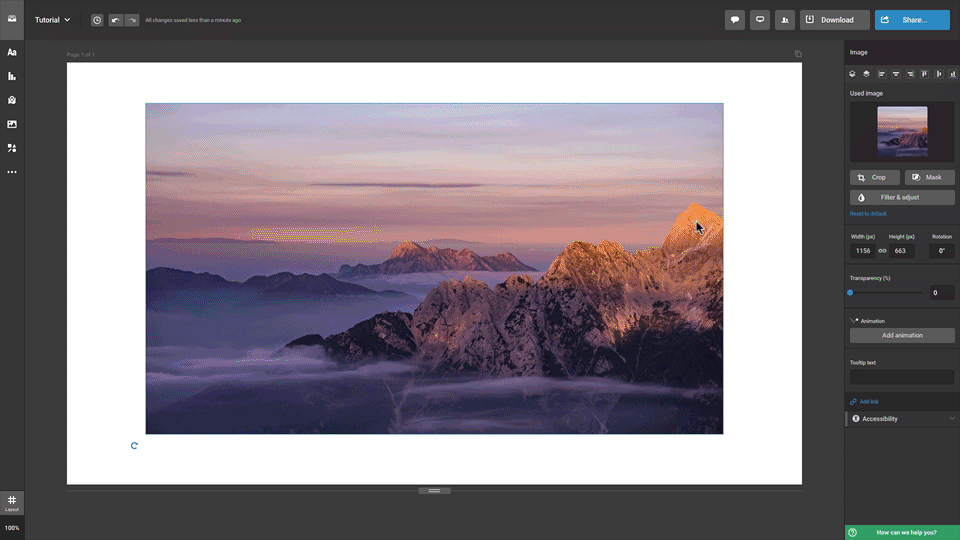10.07.2020 by Infogram
A well-written article engages and educates readers, sparks new thoughts, and allows you to become part of a larger discussion. Articles are intended to share expertise and elevate your company’s overall image and global reach.
Writing an article people actually want to read shouldn’t be too difficult, but unfortunately, it seems to trip up a lot of authors. With a few easy techniques, added visuals, and writing basics, writing articles online can go from an arduous task to something you actually enjoy doing, and better yet, people enjoy reading.
This article covers some useful tips and tricks to create informative, engaging, and useful articles. These tips are easy to replicate and offer positive and immediate results. Sharpen those pencils for six tips to write articles/blogs/posts people actually want to read!
Tip #1: Pick a catchy title

The title is the first impression of your article. Take your time to come up with a good one.
A catchy title is the hook that gets your readers’ attention and makes them want to learn more.
Here are some easy tips and ideas:
- Keep your headline short, simple, and to the point
- Use numbers to give concrete takeaways – not only will this give your readers a clear idea of the scope of the article, it will keep content more streamlined and directed to main points. Also, use a numeral like ‘5’ instead of writing the word ‘five’. Readers are more apt to click on the title with a number:
- Example: 5 secrets that help make air travel easier
- Use a question for the headline – this question should be something you clearly know your audience wants to know and they’ll respond with “Yes!” or “Tell me more!”:
- Example: Asking for a promotion? Read this first.
- Tell your audience what to do – this is an opportunity to be direct and tell your audience what to do or what value you can add:
- Example: Subscribe for free infographic templates with Prezi
Pro-tip: Avoid clickbait headlines. These are headlines that either sensationalize or mislead individuals to click into an article that links to the original content. Authors that rely on these methods quickly lose credibility and readers. And let’s face it, it’s also just annoying.
Tip #2: Write content that educates readers

Countless articles have been written that cover similar topics you might want to cover. That’s the reality, and it’s also completely fine. You can still inspire readers with your own experience combined with a well-structured article.
Write your article in a way that quickly summarizes your main points to give readers bite-sized information they can clearly understand. Individuals don’t want A LOT of content, but they do want quick fixes and easy explanations.
Bucket the content within your articles clearly. It’s easy to over-complicate topics where you’re the subject matter expert. We’re not advising to create “basic” articles, but adhering to simple article structuring that will help educate readers of all levels.
Here are some quick questions to cover when reviewing your article:
- Did I clearly state in my introduction which topics I will cover?
- Are all main topics clearly separated within the body of the article with all main questions or points answered?
- Are all references hyperlinked?
- Is there a conclusion that neatly summarizes all main points and the purpose of the article?
Pro-tip: Create a one-sentence “purpose” prior to writing your main article. The purpose is the ‘What’ and the ‘Why’ of your article. What are you trying to convey in this article and why is it important, or why should readers care? Place the purpose at the top of the article. This should not be published — it is simply an anchor to keep your writing relevant to your topic and audience.
Tip #3: Use data visualizations: Charts, graphs, or infographics
Data is one of the easiest ways to educate readers and share key points. Often, data is viewed as “boring” when it should be viewed as one of the best ways to share a story. A simple way to quickly educate readers is through data visualization.
Good data visualizations are created when communication, data science, and design collide. Data visualizations – like interactive charts, graphs, or infographics – can offer key insights into complicated datasets in ways that are meaningful and intuitive. They also help readers better retain key information and keep them engaged longer.
So, if you’d like to get better at data storytelling, check out these 4 tips on how to use data to tell a compelling story.
For example, here’s how we incorporate infographics on the Infogram blog. While a blog post on the recent statistics on Big Pharma could be very data-heavy, introducing them in the form of an infographic makes them easily digestible:
The basic thing to keep in mind is: When data is streamlined into one or two charts, color is used appropriately, and icons and images support the numbers, the story becomes easier to tell.
Pro-tips: Not sure where to start when designing a chart? Check out these 15 tips to make your chart more effective. You can also brush up on the basics of infographics here.
Tip #4: Use images
Would you rather read one page of black-and-white, single-spaced text, or three pages of the same text, interspersed with dynamic images?
Articles obviously begin with words, but adding images increases audience engagement and looks more polished and professional.
Pro-tip: Make sure your images are consistent and branded for your company’s look by using photo filters.

Spice up your images by adding filters and making other adjustments using the Infogram editor.
Tip #5: Don’t forget video
Video is a fantastic method to quickly grab your audience’s attention, summarize the end of an article (especially if it’s a rather long one), or segue into a different topic. Videos quickly capture the audience’s attention and are a preferred source of learning for multiple generations.
Learn more about how to engage your audience using videos here.
Pro-tip: Nervous you’re not a master video editor? Don’t worry! Prezi Video makes it easy. For example, here’s a Prezi Video on useful SEO tips for content marketing:
Final thoughts
Anyone can write articles or blogs that people actually want to read. Start with a catchy title, make sure your content educates the readers (and is easy to follow), and include images and interactive data where appropriate. The end result is an attentive audience that is hungry to hear more… from you!
Infogram makes it easy to polish your articles with consistent images, interactive charts and infographics, and more. Get started today.
Get data visualization tips every week:
New features, special offers, and exciting news about the world of data visualization.
